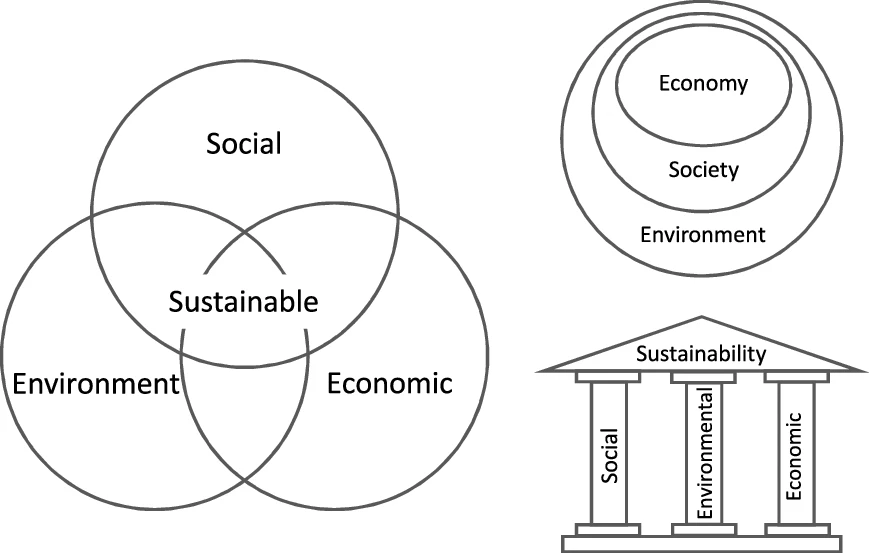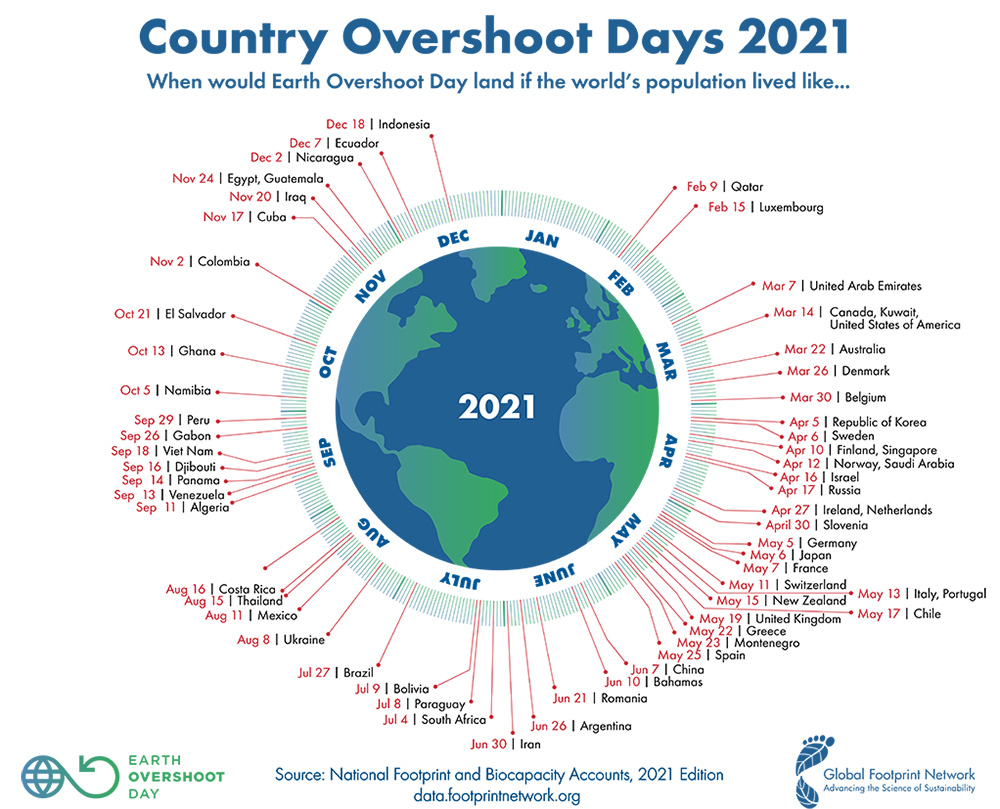Sustainable vs Unsustainable: What’s the Difference?
Impactful Ninja is reader-supported. When you buy through links on our site, we may earn an affiliate commission.
Learn more
Learn more
.
Hey fellow impactful ninja ? You may have noticed that Impactful Ninja is all about providing helpful information to make a positive impact on the world and society. And that we love to link back to where we found all the information for each of our posts. Most of these links are informational-based for you to check out their primary sources with one click. But some of these links are so-called "affiliate links" to products that we recommend. First and foremost, because we believe that they add value to you. For example, when we wrote a post about the environmental impact of long showers, we came across an EPA recommendation to use WaterSense showerheads. So we linked to where you can find them. Or, for many of our posts, we also link to our favorite books on that topic so that you can get a much more holistic overview than one single blog post could provide. And when there is an affiliate program for these products, we sign up for it. For example, as Amazon Associates, we earn from qualifying purchases. First, and most importantly, we still only recommend products that we believe add value for you. When you buy something through one of our affiliate links, we may earn a small commission - but at no additional costs to you. And when you buy something through a link that is not an affiliate link, we won’t receive any commission but we’ll still be happy to have helped you. When we find products that we believe add value to you and the seller has an affiliate program, we sign up for it. When you buy something through one of our affiliate links, we may earn a small commission (at no extra costs to you). And at this point in time, all money is reinvested in sharing the most helpful content with you. This includes all operating costs for running this site and the content creation itself. You may have noticed by the way Impactful Ninja is operated that money is not the driving factor behind it. It is a passion project of mine and I love to share helpful information with you to make a positive impact on the world and society. However, it's a project in that I invest a lot of time and also quite some money. Eventually, my dream is to one day turn this passion project into my full-time job and provide even more helpful information. But that's still a long time to go. Stay impactful,Affiliate Disclosure
Why do we add these product links?
What do these affiliate links mean for you?
What do these affiliate links mean for us?
What does this mean for me personally?
![]()
Sustainability is one of the most important topics for our environment – but it goes even beyond that. The idea has been around a while, but it has gained global attention in the late 20th and the 21st centuries as we have begun to pay closer attention to the impact that we have on our surrounding environment. So we had to ask: What’s the difference between sustainable and unsustainable?
In short, something is sustainable if it can be maintained indefinitely and something is unsustainable if it cannot be maintained indefinitely. But beyond that, sustainability is defined within the three pillars of our environment, society, and economy – and here, the differences are more nuanced.
As we strive to be a sustainable society, the first thought that comes into most peoples’ minds is to protect the environment. But is the environment the sole factor that determines if we are sustainable? Below we will explore what it means to be sustainable in terms of environment, economics, and society and how that differs from being unsustainable. We will also discuss a prominent example of sustainable vs. unsustainable.
How Are Sustainability and Unsustainability Defined
To showcase the differences between sustainable and unsustainable, let’ start with the first step and define the two. There are simple definitions for both sustainable and unsustainable as well as three pillars of sustainability that go deeper into examining what it means to be truly sustainable in terms of our environment, society, and economy.
What Does the Dictionary Say About Sustainability and Unsustainability
Sustainability is the ability to meet our current needs without compromising the ability of future generations to meet their own needs.
“Sustainable: The ability to be maintained at a certain rate or level | Avoidance of the depletion of natural resources in order to maintain an ecological balance”
Oxford Dictionary
The general goal of sustainability is to maintain homeostasis between people and their environment, but unsustainable practices thwart this goal.
“Unsustainable: Something that is unsustainable cannot continue at the same rate | Causing damage to the environment by using more of something than can be replaced naturally”
Cambridge Dictionary
If something is unsustainable, it cannot be continued at the same pace, level, rate, etc. In other words, it is anything that cannot be prolonged or continued.
Sustainability is a broad topic that includes more than just taking care of our environment. It also relies on economic and social factors that, when working together, can contribute to complete sustainability.
What Are the Three Pillars of Sustainability?
Norwegian prime minister Gro Harlem Brundtland coined the phrase “three pillars of sustainability” in 1987 in his report for the United Nations’ World Commission on Environment and Development titled Our Common Future. The most known and most referenced pillar by far is environmental sustainability, but did you know that it also includes economic and social factors as the other two pillars?
The three pillars of sustainability are environmental, economic, and social sustainability. There is a great deal of overlap between the three, and the goal is to combine all three to attain long-term prosperity and preserve our world for the generations yet to come. Environmental limits place a great deal of strain on the limits of our economy and society.
These three pillars of sustainability are typically represented as three intersecting circles (on the left) or, alternatively, as literal ‘pillars’ or a concentric circles approach (on the right):

- Environmental sustainability (planet): Maintaining ecological integrity, balancing environmental systems, and consuming natural resources at a rate by which they can replenish themselves.
- Economic sustainability (profit): The ability of an economy to support a level of economic production indefinitely
- Social sustainability (people): Identifying basic human rights and needs that people require to live healthy and secure lives. Protection against discrimination and upholding personal, labor, and cultural rights.
So why do we, or should we even, care so much about the difference between sustainability and unsustainability? It all comes down to the kind of life we want to leave for future generations. Studying the interactions between the three pillars can shed light on the consequences that unsustainable actions can have.
What Are the Differences Between Sustainable and Unsustainable?
Now that we have defined sustainable and unsustainable, we can explore the differences between the two in terms of environmental, economical, and social factors.
| What is sustainable? | What is unsustainable? | |
| Environmental sustainability | Preservation of natural resources | Exploitation of resources faster than the planet can handle and replenish |
| Economic sustainability | Long-term economic growth without negatively impacting our environment or society | Not quantifying ecosystem services at and increased vulnerability to crises |
| Social sustainability | Equality, diversity, social cohesion, and democracy | Racism, labor laws, human rights, gender inequality, and poor treatment of indigenous peoples |
Below are the key differences between the three pillars in regards to being sustainable and unsustainable. Food waste is used as an example in all three pillars to create a common thread.
Differences on an Environmental Level
Being environmentally sustainable means interacting with the planet in a way that preserves natural resources and maintains global ecosystems for future generations to use. It begins with us paying more attention to global environmental concerns and evaluating our use of natural resources and our collective carbon footprint.
“[We reaffirm the need to] promote the integrated and sustainable management of natural resources and ecosystems that supports, inter alia, economic, social and human development while facilitating ecosystem conservation, regeneration and restoration and resilience in the face of new and emerging challenges.”
United Nations: The Future We Want (2012)
The environmental sustainability pillar encompasses 6 subtopics:
- Ecosystem services
- Green engineering
- Green chemistry
- Air and water quality
- Stressors
- Resource integrity
We can environmentally be sustainable by protecting ecosystems, using chemicals that are not hazardous, maintaining a high air and water quality standard, reducing the greenhouse gas effect, and minimizing waste generation. If we can do all of this, the planet will be a much more sustainable place for us and future generations to live.
However, we are environmentally unsustainable because we exploit more resources faster than the planet can handle and replenish. Wastage of food, water, and resources is one of the most obvious ways that we are environmentally unsustainable.
One very visual representation of this is the Earth Overshoot Day: Earth Overshoot Day is the calculated illustrative calendar date on which humanity’s resource consumption for the year exceeds Earth’s capacity to regenerate those resources that year. And in 2020, it landed on August 22.
This means that we’d only be sustainable – from an environmental perspective – if we use as many resources for the whole year as we’ve used until our Earth Overshoot Day. Everything beyond tips us into becoming environmentally unsustainable.
Have a look at the illustration below to find out how that looks like for your country! Your country-specific day is even quite a bit earlier, isn’t it?

Let’s take food waste as a concrete example here: it is estimated that we waste 40% of our food each year. Food waste is the largest component of municipal waste, and it breaks down over time and releases methane, a greenhouse gas 86 times more potent than carbon dioxide.
Any step towards environmental sustainability, whether incremental or transformative, can make a big difference in our planet’s health. Whether you reduce your own carbon footprint by using less electricity or you are part of a team that invents a new technology to reduce greenhouse gas emissions, every little bit helps.
Differences on an Economic Level
Economic sustainability is tightly linked with environmental sustainability because businesses make economic decisions that have major impacts on the health of the environment.
“We also reaffirm the need to achieve sustainable development by promoting sustained, inclusive and equitable economic growth, creating greater opportunities for all, reducing inequalities, raising basic standards of living, fostering equitable social development and inclusion.”
United Nations: The Future We Want (2012)
The economic sustainability pillar encompasses 6 subtopics:
- Jobs
- Incentives
- Supply and demand
- Natural resource accounting
- Costs
- Prices
We can economically be sustainable by promoting long-term economic growth without negatively impacting our environment or society. In addition, strengthening current jobs, promoting informed marketing and accounting practices, improving quantification of ecosystem services, developing waste-free processes, and reducing the risk and premium for new technologies all promote economic sustainability.
However, we are economically unsustainable because we do not properly quantify ecosystem services, known as the benefits that environmental systems provide, and increase vulnerability to crises. Our practices currently do not support long-term economic growth without negatively impacting our environment or society. The problem is that it is almost always cheaper to buy a product that has a worse impact on the environment (and society) than an equivalent that does less harm. Not putting a price tag on natural resources creates the false pretense that there is no trade-off to their use. In reality, there is always a trade-off, and the environment suffers more often than not.
For our example, food waste is economically unsustainable because we lose approximately 218 billion dollars per year by wasting 40% of our food. That money could have been allocated to funding renewable resource initiatives, environmental education programs, or human health campaigns.
Practicing sustainable business practices and asking the question “how can we minimize impacts” rather than “how can we turn a profit” is how a business can be sustainable. To be sustainable, the demand for natural resources must be less than the renewable supply of resources.
Differences on a Social Level
Social sustainability is often left out of the sustainability discussion; however, sustainable societies begin and end with the people that reside in a given community.
“We recognize that poverty eradication, changing unsustainable and promoting sustainable patterns of consumption and production and protecting and managing the natural resource base of economic and social development are the overarching objectives of and essential requirements for sustainable development.”
United Nations: The Future We Want (2012)
The social sustainability pillar encompasses 6 subtopics:
- Environmental justice
- Human health
- Participation
- Education
- Resource security
- Sustainable communities
We can socially be sustainable by fostering equality, diversity, social cohesion, and democracy. In addition, protecting communities’ health, sustaining and improving human health, engaging stakeholders in processes, increasing sustainability education, protecting and maintaining access to basic resources such as food and water, and promoting communities all embody sustainable living.
However, we are socially unsustainable because racism, labor laws, human rights, gender inequality, and poor treatment of indigenous peoples are all prominent social issues in our world today. They divide and alienate people rather than striving for equality, social cohesion, and diversity.
To continue with our example, food waste is not just an environmental and economic issue. 10.5%, or approximately 13.7 million, households experienced some degree of food insecurity in 2019. Food insecurity is a social issue and one that could be minimalized if better care was taken to avoid wasting food.
Creating sustainable places that promote well-being is the goal of social sustainability. It combines the physical world with the social world to create an environment that can continuously evolve and advance.
Energy: The Most Prominent Example of Sustainable vs Unsustainable
Energy, and where we get our energy from, is probably the most common point of discussion when talking about resource sustainability. Some suggest we are in an energy crisis because we cannot continue to meet our energy needs given our current rate of consumption and population growth.
The following have all been listed as causes of unsustainable energy usage:
- Overconsumption
- Overpopulation
- Poor infrastructure
- Unexplored renewable energy options
- Delay in commissioning power plants
- Wastage of energy
- Poor distribution systems
To be environmentally sustainable is to utilize natural resources that can replenish themselves faster than we can consume them. These resources include solar power, wind power, hydropower, geothermal energy, and biomass. They are sustainable because they are either always there, no matter if we use them or not, or they are able to regenerate after we use them, and thus will never run out.
To be environmentally unsustainable is to deplete natural resources faster than they can regenerate. Nonrenewable resources are finite and are therefore unsustainable. We are currently depleting nonrenewable resources (coal, oil, and natural gas) at an alarming rate. As of 2015, at this rate, we will run out of coal by 2130, natural gas by 2069, and oil by 2067. This means we have approximately 50 years left of oil and natural gas.
Another point of concern is that we may have already exceeded Earth’s carrying capacity or the maximum number of people that the earth can sustain indefinitely. Our population is rapidly approaching 8 billion and increases by approximately 140 million people per year. The ecological footprint, the amount of environmental land needed to produce the goods that support a particular lifestyle, also continues to increase which means we are impacting the environment at levels that cannot be sustained indefinitely.
Final Thoughts
Sustainability encompasses the environment, economy, and society by aiming to meet the needs of the current generation without compromising the ability of future generations to meet their needs. Sustainability practices are indefinite whereas unsustainable practices are finite.
Although environmental sustainability is the prominent subdivision of sustainability, economic and social factors need to be taken into account when discussing sustainability. These two factors have the potential to impact the environment in positive or negative ways, depending on if the factor is sustainable or unsustainable.
We are currently on a path that is unsustainable because our rate of consumption exceeds what the planet can handle indefinitely. In order to ensure that future generations have access to the same resources we have now, we must make an effort to live sustainably in terms of the planet, the economy, and the people that live here.
Stay impactful,

Sources
- Gro Harlem Brundtland: Our Common Future – Call for Action
- McGill: What is Sustainability?
- Oxford Dictionary: Definition of Unsustainable
- Sustainable Science: Three pillars of sustainability: in search of conceptual origins
- U.S. Environmental Protection Agency: Sustainability Primer
- Scholarworks: Environmental Sustainability – A Definition for Environmental Professionals
- Earth Overshoot Day: 2020 Calculation
- Global Footprint Network: Country Overshoot Days
- Boston College Center for Corporate Citizenship: Environmental Sustainability
- Australian Academy of Science: How many people can Earth actually support?
- The World Counts: How many babies are born a day?
- The One Brief: Why Environmental Sustainability is Becoming Big for Business
- Econation: Sustainable Economy
- FoodPrint: The Problem of Wasted Food
- Process.St: Economic Sustainability For Success: What It Is And How To Implement It
- Diversity for Social Impact: Social Sustainability – Everything You need to know
- ADEC Innovations: What is Social Sustainability?
- United Nations: Social Sustainability
- U.S. Department of Agriculture: Food Security in the U.S.
- Market Business News: What is Unsustainable? Definitions and Examples
- Our World in Data: How long before We Run Out of Fossil Fuels?




